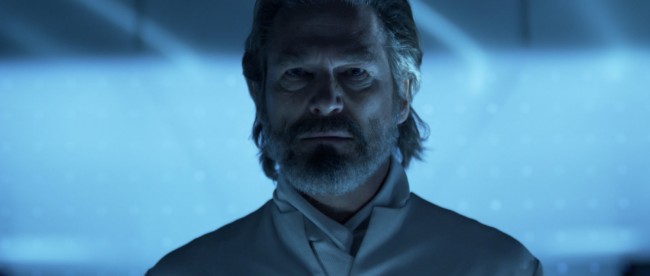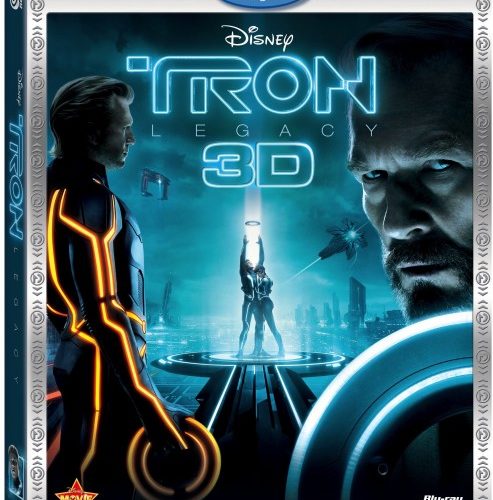
TRON: Legacy is both distancing and oddly engaging. This 28-years later sequel could not be more similar to the first installment. It runs at a mild pace, is more technically impressive rather than thematically and there’s not a whole lot of compelling drama. That’s not to say Joseph Kosinski‘s directorial debut isn’t without some soulful inspiration. The man’s clearly pulling at some heartstrings throughout, and while it doesn’t hit its mark, the attempt feels admirable.
The original TRON is, by no means of the imagination, a genuine classic. It’s a B-level adventure film, sort of like the younger and less impressive brother of Star Wars. The original truly got by on having the advantage of the charismatic Jeff Bridges. His charms and likability sold the world of the Grid. Bridges made a goofy story-line believable and fun. And also, there were those never-before-seen special effects. This time around, for better or (mostly) worse, Bridge’s Kevin Flynn is not our hero. Instead, it’s Sam Flynn (Garret Hedlund). And though there be a considerable amount of not-so-flattering buzz about Hedlund’s performance leading up to the release, and those early reports are a bit hyberbolic.The young actor makes for a serviceable, if a bit bland, leading man.
Nearly 20 years after the mysterious disappearance of his father, Kevin Flynn, Sam’s the owner of his father’s company, ENCOM. Unfortunately, Kevin has no interest in running ENCOM. This set-up runs nearly 20 minutes, allows for an action sequence and works well enough, though a lot of it doesn’t feel totally tied to what’s going on in the grand scheme of things. And really, the Grid is the true selling point of the film. I don’t think anyone is going into TRON: Legacy is going for all the ENCOM corporate mumbo-jumbo talk. Kosinski and writers Adam Horowitz and Edward Kitsis make a vibrant and impressive Grid. It’s visually stunning, all the vehicles and landscapes beautifully crafted.

The villain this time around is Clu, played by a de-aged Jeff Bridges. Kevin Flynn’s disappearance completely stems from Clu, his own creation. Flynn created him to help build the perfect utopia, which didn’t quite pan out the way he expected. The eccentric inventor ended trapped in the Grid, hiding from Clu, who needs Flynn’s light disc (i.e. the film’s MacGuffin). As expected, Clu’s plan is fairly ridiculous. That wouldn’t be so much a problem if his goofy scheme had any sense of stakes to it. Clu’s genius idea is to breakout of the Grid along with his “apparently” massive army to take over the real world — if I recall correctly.
The issue is that his Bond villain-esque scheme isn’t introduced until far too late in the game. Where’s the buildup? What would Clu’s plan, if it actually succeeded, do to humanity? No idea? Well, that’s understandable. Clu is an interesting idea for a villain that never becomes the true menace the concept perhaps initially suggested. His plan never feels threatening and he never feels dangerous. Even Kevin Flynn doesn’t seem all that worried about his diabolical plan. Clu himself looks finely rendered. There’s a few moments where the de-aged Kevin Flynn and Clu look slightly off, but the effect ultimately works. It strikes a balance between being both cartoony and lifelike.
The whole plot is basically a get from point A to point B adventure. It’s a fairly simple plot stretched out, the second act especially could have used some slimming down. When Sam finally meets up with Poppa Flynn, they set their eyes on escape. It doesn’t take Sam long to find his father (conveniently) once in the Grid, thanks to Quorra (Olivia Wilde). Wilde brings a childlike playfulness to the female heroine role. Quorra is charming, and she’s the only one I truly hoped for to make it out of this scenario alive and well. Quorra doesn’t contain the meatiest of arcs and she doesn’t play in the action as much as she should, but she’s likable and charismatic.

TRON: Legacy makes for a decent enough spectacle. The action is well-crafted and much of the imagery is full of awe, and Daft Punk’s score makes a handful of those moments truly pop. If it lost 20-minutes and tighter and clearer plotting, this oversized popcorn film could have been something more special. Kosinksi ends on the expectedly blatant sequel flag, which is usually bothersome, but there’s certainly nothing wrong with hoping for more adventures in the Grid. This feels like a second chapter in something big, and a stronger climax is welcomed.

Video: The spectacle of TRON: Legacy is all that it’s about, so to no surprise, Disney made sure the picture for the Grid is as perfect as one would want it to be. The dark palette and details of Kosinski’s computer world manages to still provoke a sense of awe and eye-numbness. To keep inline with the IMAX experience, the picture fluctuates from 1:78:1 and 2:35:1. The adjustments are seamless and never distracting, similar to The Dark Knight‘s blu-ray.

Audio: The audio is clean and pristine. While Daft Punk’s score did make the film feel more like a music video rather than an actual movie at times, you’ll find yourself basking in the overbearingness of the audio transfer and how fantastic the score sounds. The battles and action, which there’s not much off, is as bombastic as can be. All the conversations are crisp as well. Like the technicality of TRON: Legacy, the audio impresses.

Special Features: “Meh” is the most appropriate way to critique these features. While not as nearly headache-inducing as the EPK fluff, it’s a real shame Disney didn’t put more effort into a more extensive and interesting array of features. Most fans will find themselves disappointed by the lack of detail, and the same goes for non-fans looking for insight into behind-the-scenes of how the Grid was crafted. The only notable feature is “Visualizing Tron,” but even that lacks much needed attention to detail.



